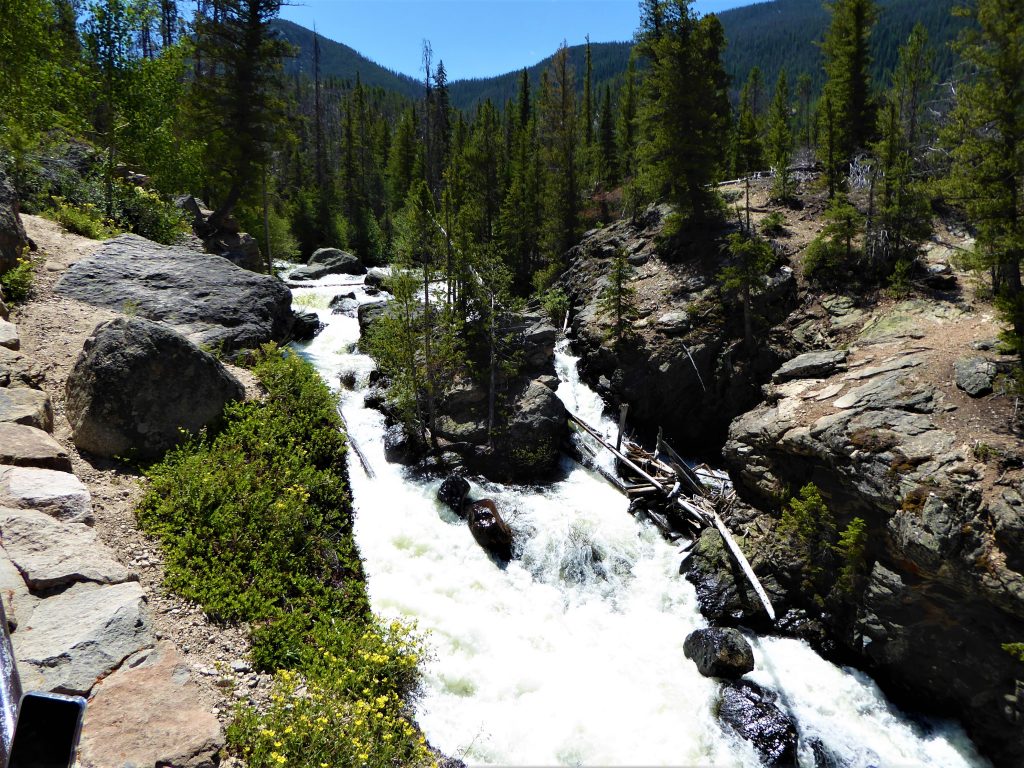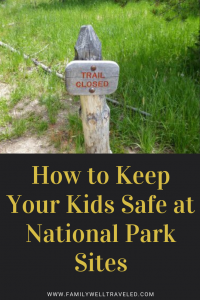Keeping Your Kids Safe at National Parks

It happened again. We saw another video of a child attacked by a bison at a national park site. Every year, we see videos of animals attacking people at our parks. And the animals are not to blame. They are acting instinctively. However, there is no reason for these tragedies to occur. We have visited dozens of national parks, and we always see signs posted warning visitors of potential dangers within those parks. It is a parent’s responsibility to keep kids safe while exploring our parks. So here are our best tips for keeping your kids safe at national parks.
Research Before Entering the Park
The U.S. National Park Service website is the go-to source for preparing for a visit to one of the park sites. We always head to the website before going to the park. Why? Not only does the website give great details about your park (such as directions, things to do, and history of the site), it also provides alerts for each site.
Roads may be closed. Hiking trails wash out. Spring runoff creates dangerous avalanche or raging river conditions. There are any number of alerts posted on the website. We’ve prepared for alternative activities at parks due to the posted alerts.
Talk to Your Kids About Potential Dangers
Before we ever enter a national park site, we talk to our kids about potential hazards.
If we’re visiting a park with lots of wildlife, we reiterate the importance of keeping a distance from the animals. That may not be necessary if you spot a bear, but it may be necessary if you see a bison or groundhog.
If we’re visiting a site with rivers and streams, we remind our kids to be cautious so they are not swept away in the rushing waters. Recently, we visited Rocky Mountain National Park in the spring. Alerts warned about raging rapids due to heavy runoff. We made sure our kids knew before hiking near those rivers.
Make Sure Your Kids Are in Eyesight

We love our kids’ growing independence. As they feel more comfortable in their skin, they are venturing out from the nest more and more. But, there is a time and place for this. When we visit a national park site, we make sure to remind the kids to stick close to us.
Although it may seem overcautious, there really is no way to know what may lie around the bend of a road. We wouldn’t want to lose our kids to an unexpected animal attack when they have run ahead of us. Our daughter is fearless and unafraid of heights. We’ve watched her rush headlong to the edge of cliffs or waterfalls, completely oblivious to potential peril should she slip. And, of course, in today’s world, you can never be too sure that the friendly person on the hiking trail has your best interest at heart.
It may seem like overkill, but we think a little extra caution is worth it to protect the kids.
Stay on Designated Trails
We read signs at every park site instructing visitors to stay on the trails. There are a number of reasons for this warning.
First, the park preserves as much of the natural landscape as possible. Staying on the trails helps preserve the flora and fauna of the park.
Second, there are unknown dangers when leaving the marked paths. Rangers post signs when they are aware of dangers you may not know about.

It seems obvious to obey the posted signs. But we have seen people take their kids off the geyser trails in Yellowstone, where they could be scalded by the scorching vapors. We’ve seen people leave trails to walk on wet rocks to get a better picture of a waterfall. One slip could bring tragedy.
Know Your Limits
Are you aware how much your kids can handle? Are they able to complete a 10-mile hike without complaint? Will they acclimate to a high elevation park site? Are they afraid of heights?
Although you want to do everything you can at a national park, it’s best to know your limits. We took a grueling tour of Balcony House at Mesa Verde National Park. The tour involved climbing through narrow spaces and ascending steep ladders and steps. The tour was worthwhile, but we knew our kids’ limitations. Knowing our son has a fear of heights, we prepared him for the steep ascents.
You may want to do everything, but keeping safe involves declining some adventures that are too much for your family.
Pack All the Essentials
Weather is unpredictable. You can’t predict it, but you can prepare for it. Even in the middle of summer, we’ll pack long pants and jackets when visiting national parks. We’ve learned the hard way after reaching a park only to find a fierce winter snowstorm once there.
Also, make sure to pack sunscreen, hats, bear repellent, and other essentials. Have plenty of water and snacks, too. Many park sites have no food sold on site. So if you’re planning a long stop there, you want to have food for your kids.
Have proper hiking boots for your kids if you’re planning alpine or rocky hikes. A First Aid kit isn’t a bad idea, either.
Check with the Visitor’s Center for Same Day Hazards
Nothing beats firsthand knowledge. Even checking the park website before the trip may not be enough.
Check at the Ranger entrance station or the visitors center for any same day troubles. Hikers might report a washed out road before you plan your hike on that trail. Visitors may warn of rambunctious animals posing threats to people at a picnic area.

On one of our visits, we saw a prairie rattlesnake slithering across a path at Fort Union National Monument. From a safe distance, we snapped a photo and reported the sighting to the Rangers at the visitors center. They confirmed that the snake was dangerous, sent someone out to try to find it, and reported the sighting to newly arriving visitors.
Adhere to All Posted Signs and Directions
Stay 100 yards away from wildlife. Do not feed the wildlife. Turn around. Stay off trail.
Whatever the posted sign, make sure you and your kids follow the directions. Unfortunately, many of those signs have been posted because of an injury or tragic circumstance. Knowing that, why would you place yourself, or your kids, in harm’s way.
Heed the signs. Stay Safe.
These are some of the best practices for keeping your kids safe at national parks. Hopefully, with some preparation before your visit and some astute observations during your stay, you and your kids will enjoy an unforgettable and safe trip to a national park site.
You Might Also Enjoy:
Read how your kids can become Junior Rangers while visiting a national park site.
See our photo tribute to the National Park Service.


All photos and content are by Family Well Traveled and use of photos or content without permission will result in legal action.
